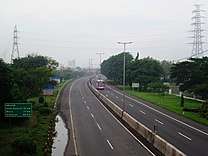East Java
East Java (Indonesian: Jawa Timur) is a province of Indonesia. It has a land border only with the province of Central Java to the west; the Java Sea and the Indian Ocean border its northern and southern coasts, respectively, while the narrow Bali Strait to the east separates Java from Bali. Located in eastern Java, it also includes the island of Madura, which is connected to Java by the longest bridge in Indonesia, the Suramadu Bridge, as well as the Kangean and Masalembu archipelagos located further east and north, respectively. Its capital is Surabaya, the second largest city in Indonesia, a major industrial center and also a major business center. Banyuwangi is the largest regency in East Java and the largest on the island of Java.[6]
East Java | |
|---|---|
 Flag 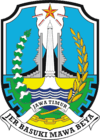 Coat of arms | |
 Location of East Java in Indonesia | |
| Established | 25 February 1950 |
| Capital and largest city | Surabaya |
| Government | |
| • Body | East Java Provincial Government |
| • Governor | Khofifah Indar Parawansa |
| • Vice Governor | Emil Dardak |
| Area | |
| • Total | 47,799.75 km2 (18,455.59 sq mi) |
| Area rank | 14th in Indonesia |
| Highest elevation | 3,676 m (12,060 ft) |
| Population | |
| • Total | 39,744,800 |
| • Rank | 2nd in Indonesia |
| • Density | 830/km2 (2,200/sq mi) |
| Demographics | |
| • Ethnic groups | 80% Javanese 17% Madurese 3% Chinese[3] |
| • Religion in Indonesia | 96% Islam 2.4% Christianity 0.6% Buddhism 0.5% Hinduism 0.1% Confucianism 0.04% other (including Kejawen)[4] |
| • Languages of Indonesia | Indonesian (official) Javanese (regional) Osing, Madurese, Tenggerese |
| Time zone | UTC+7 (Indonesia Western Time) |
| ISO 3166 code | ID-JI |
| HDI | |
| HDI rank | 15th in Indonesia (2019) |
| GRP Nominal | |
| GDP PPP (2019) | |
| GDP rank | 2nd in Indonesia (2019) |
| Nominal per capita | US$ 4,191 (2019)[5] |
| PPP per capita | US$ 13,775 (2019)[5] |
| Per capita rank | 8th in Indonesia (2019) |
| Website | jatimprov |
The province covers an area of 47,800 km2, According to the 2010 Census, there were 37,476,757 people residing in the East Java, making it Indonesia's second-most-populous province; the latest official estimate (for mid 2019) is 39,744,800.[7] East Java is inhabited by many different ethnic groups, such as the Javanese, Madurese and Chinese. Most of the people in East Java adheres to Islam, forming around 96% of the total population. Other religions are also worshipped, such as Christianity, which are mostly worshipped by Chinese Indonesians and immigrants from Eastern Indonesia and North Sumatra, and also Hinduism which are mostly worshipped by the Tenggerese people in the Bromo Tengger Semeru National Park and the Balinese people inhabiting the easternmost part of the province bordering Bali. The Indonesian language is the official language of the province as well as the whole nation, but Javanese and Madurese are the most frequently used language. Indonesian is only used for inter-ethnic communication and official purposes.
East Java is one of the provinces in Indonesia that offers different types of tourist attractions. This area offers a variety of natural attractions ranging from mountains, beaches, caves, to waterfalls. In general, almost every regencies or city in East Java has its own unique tourist destinations, such as the Ijen volcano in Banyuwangi, Baluran National Park in Situbondo, Bromo Tengger Semeru National Park, etc.
History
Prehistory
East Java has been inhabited by humans since prehistoric times. This can be proven by the discovery of remains from fossils of Pithecanthropus mojokertensis in Kepuhlagen, Mojokerto;[8] Pithecanthropus erectus on Trinil, Ngawi;[9] and Homo wajakensis in Wajak, Tulungagung.[10]
Pre-Islamic era

The Dinoyo inscriptions found near the city of Malang are the oldest written sources in East Java, dating from 760 CE. They tell of many political and cultural events in the Kingdom of Dinoyo. The name of Malang is thought to come from the name of a sacred building called Malangkuseswara. This name is contained in at least one inscription, namely, the Mantyasih inscription written in 907 CE.
In 1222, Ken Arok founded the Kingdom of Singhasari, which he ruled until 1292. Before coming to power, Ken Arok seized power in Tumapel (Kediri) from Tungul Ametung. Ken Arok dynasty's descendants became kings of Singhasari and Majapahit from the 13th until the 15th century.
In 1227, Anusapati killed Ken Arok, and later became king of Singasari. Anusapati's power only lasted 20 years, before he was killed by Tohjaya. Three years later, Tohjaya was killed in the uprising led by Jaya Wisnuwardhana, son of Anusapati. In 1268, Wisnuwardhana died, and he was succeeded by Kertanegara (1268-1292). In 1292 Kertanegara was defeated by a rebel named Jayakatwang, ending the power of Kertanegara and the history of Singhasari.
In 1293, Kublai Khan, founder of the Yuan dynasty, sent a large invasion fleet to Java with 20,000 to 30,000 soldiers, beginning the Mongol invasion of Java.[11] This was a punitive expedition against King Kertanegara of Singhasari, who had refused to pay tribute to the Yuan and maimed one of its ministers. However, it ended with failure for the Mongols.
In 1294, the Kingdom of Majapahit was founded. Its founder was Raden Wijaya. Majapahit reached its peak during the reign of Hayam Wuruk. He was accompanied by the mahapatih Gajah Mada. Together they managed to unite the vast territory under the name Dwipantara. Majaphit later developed to become one of the strongest empire in Southeast Asia.
In 1357, the Bubat event occurred, the war between the King of Sunda and the Majapahit Patih Gajah Mada. This event stems from the desire to take the king Hayam Wuruk Sundanese princess named Dyah Pitaloka as queen. However, because of a misunderstanding about the procedure of marriage, the plan led to a battle in Bubat. Majapahit troops, under the command of Gajah Mada defeated Pajajaran. In 1389, Hayam Wuruk died, and was succeeded by Wikramawardhana. This resulted in the beginning of the decline of the Majapahit Empire. As the Majapahit Empire went into decline in the late 1300s, Islam moved to fill the vacuum.[12]
Islamic era
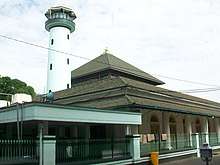
The precise date when Islam enters Java remains unclear. This is due to the absence of a definite source regarding the arrival of Islam in Java. However, according to some experts, it is estimated that Islam entered Java around the 11th century with evidence of the tomb of Fatimah Binti Maimun in the village of Leran in Gresik Regency which dates from 475 AH (1085 AD). The tomb also shows that in the 11th century the North coast of Java had begun to be frequented by Arab traders from the Middle East. In addition, several Islamic tombs were discovered in Trowulan, located in what is now part of the Mojokerto Regency, near the site of the former Majapahit palace.[13]
On the 15th century, a Chinese Hui voyager named Ma Huan (simplified Chinese: 马欢; traditional Chinese: 馬歡; pinyin: Mǎ Huān) visited East Java. He then wrote the book Yingya Shenglan (simplified Chinese: 瀛涯胜览; traditional Chinese: 瀛涯勝覽; pinyin: yíngyá shènglǎn), which tells the story of the countries visited by him over the course of the Ming treasure voyages. He mentioned that at that time there were three different kind of people inhabiting Eastern Java: Arabs from the Middle-East, the ancestor of the modern Arab Indonesians; Chinese Muslims originating from the modern-day Guangdong province, and the native Javanese people.[14]
By the 16th century, the Majapahit Empire was defeated by the Islamic kingdoms in Java, resulting in the exiles of many Majaphit aristocrats to the neighbouring island of Bali.[15] Those who remained in Java are forced to convert to Islam, while a small pocket of isolated people living in the Bromo Tengger Semeru National Park spread around Pasuruan, Probolinggo, Malang, and Lumajang Regencies remains adhered to Hinduism to this day. They are known as the Tenggerese people. Their population of roughly 100,000 is centered in 30 villages in the isolated Tengger mountains.[16]
When the Islamic sultanates started ruling Java, cities in the northern coast started developing to become a thriving port. One of them is the town of Tuban. Tuban was a wealthy and important port with many Chinese settlers. Being the port of Majapahit and the point of departure for the Moluccas, it exported an abundant supply of foodstuffs, and imported a rich variety of products from the Moluccas.[17] At the end of the 16th century, the development of Islam had surpassed Hinduism and Buddhism as the dominant religion in Java. The emergence of the Islamic kingdom on Java is also inseparable from the role of Walisongo. At first the spread of Islam was very rapid and was accepted by ordinary people, until finally the da'wah entered and was carried out by the rulers of this island.
European colonization
The relationship between the Javanese and European colonial powers began in 1522, with the signing of a treaty between the Sunda Kingdom and the Portuguese Empire in Malacca. After the failure of the treaty, the Portuguese presence was then limited to Malacca in the Malay Peninsula and the Maluku Islands. An expedition under the leadership of the Dutch exploler Cornelis de Houtman consisting of four ships in 1596 became the beginning of Dutch presence in the island.[18] At the end of the 18th century, the Dutch had succeeded in expanding their influence on the Islamic sultanates in the interior of the island of Java.
At the onset of the Napoleonic Wars, the British conquered Java in 1811. Java later briefly became part of the British Empire, with Sir Stamford Raffles as its Governor-General. In 1814, Britain returned Java to the Netherlands as stipulated in the Anglo-Dutch Treaty of 1814.[19]
Japanese occupation and revolution
.jpg)
During the Japanese occupation of the Dutch East Indies, there was persistent resistance against the Japanese rule. In Blitar, an uprising by PETA (Defenders of the Homeland) led by Supriyadi, Moeradi, Halir Mangkudijoyo, and Soemarto occurred in early 1945, but it was crushed by the Japanese.
Two weeks after the proclamation of independence, Surabaya established its own government in the shape of a resident, R. Sudirman. The formation of government in Surabaya caused disputes between the republican forces and Japanese troops, resulting in various skirmishes across the city. This was because when the Japanese surrendered, they were obliged to remain in power until the allied forces arrived. The arrival of Allied forces in Surabaya created tensions with the newly established government of Indonesia, reaching peak on 10 November 1945 where a major battle between the Surabayan residents led by Sutomo and Allied forces.
The battle forced the governor, Suryo, on the advice of People's Security Army (TKR), to move the seat of the government to the Mojokerto area. A week later, the government retreated again to a more secure location in Kediri. However, security situation Kediri worsen until finally, in February 1947, the East Java provincial government fled to Malang. While the administration was based in Malang, Gobvernor Suryo was replaced by R.P. Suroso, who was in turn replaced again by Dr. Moerdjani. On 21 July 1947, although still bound by the Linggadjati Agreement and a ceasefire agreement in effect since 14 October 1946, the Dutch commenced a military action, Operation Product, which led to deteriorating security conditions in Malang. The East Java provincial government finally moved again to Blitar.
This military action ended after the Renville Agreement. However, this agreement had negative consequences for East Java, namely, a reduction in the territory controlled by the East Java provincial government. The Netherlands then turned the areas under its control into new states, such as the State of Madura and the State of East Java. Amid the difficulties faced by the government of Indonesia, a left-wing opposition group, Front Demokrasi Rakyat (FDR, People's Democratic Front) launched rebellion in Madiun on 18 September 1948, which is known as the Madiun Affair. However, eventually this revolt was defeated by the Indonesian Army. On 19 December 1948, the Dutch launched Operation Kraai. Blitar, which the seat of the East Java provincial government was attacked by the Dutch. Governor Dr. Moerdjani and his staff were forced to flee and joined the guerrillas on the slopes of Mount Willis. Operation Kraai ended after the Roem–Van Roijen Agreement on 7 May 1949.
Following the Dutch–Indonesian Round Table Conference, at which the Netherlands agreed to transfer sovereignty to the United States of Indonesia, the Dutch withdrew its troops from East Java. East Java changed its status from a province into a state. However, on 25 February 1950, this was dissolved and became part of the territory of the Republic of Indonesia. The State of Madura also decided to join Indonesia.
Contemporary era
Along with rapid growth of urbanization in East Java, the governments could not satisfy the population's needs for affordable housing, which led to the building of shanty towns along the rivers and rail tracks. Today, the shanty towns still exist; although some have been transformed into “better” housing.[20]
East Java has twice hosted the National Sports Week (PON), namely PON VII in 1969, and PON XV in 2000, and became the overall champion of PON in 2000, and 2008. Since 1996 the East Java Football Team has always won medals gold was included in 2008, and was recorded as the fourth gold medal received consecutively. In 2021, East Java also hosted the 4th Asian Youth Games.
Geography

East Java province borders the Java Sea in the north, the Strait of Bali in the east, the Indian Ocean in the south, as well as the Central Java province in the west. The length of the east-west stretch of about 400 km. The width of the stretch of the north-south in the west about 200 km, but in the eastern part of narrower by about 60 km. Madura is the largest island in East Java, separated from the mainland Java by the Strait of Madura. Bawean Island is located about 150 km north of Java. In the east of Madura there are a cluster of islands, the easternmost is Kangean Island and the northernmost is Masalembu Islands. In the southern part there are two small islands namely Nusa Barong and Sempu Island.
Geology
In physiographic of geology, East Java Province can be grouped into three zones: the southern zone (plato), the middle zone (volcanic), and the northern zone (folds). Lowlands and highlands in the middle (of Ngawi, Blitar, Malang, to Bondowoso) has a fairly fertile soil. In the northern part ( Bojonegoro, Tuban, Gresik, to Madura Island) lies the Kapur Utara mountains and the Kendeng mountains which are relatively barren.
In the middle of the province stretch mountain ranges and volcanoes: On the border with Central Java is Mount Lawu (3,265 metres). Southeast from Madiun is Mount Wilis (2,169 metres), and Mount Liman (2,563 metres). In the middle of the corridor lies the Anjasmoro mountains with peaks Mount Arjuno (3,339 metres), Mount Welirang (3,156 metres), Mount Anjasmoro (2,277 metres), Mount Kawi (2,551 metres), and Mount Kelud (1,731 metres); The mountains are located in most Kediri, Blitar, Malang, Pasuruan, Mojokerto and Jombang. The group has the peak of Mount Bromo Tengger (2,329 metres), and Mount Semeru (3,676 metres). Mount Semeru, which is also called Mahameru is the highest mountain in the island of Java. In the easternmost part if the province, there are two groups of mountains: the Iyang mountains with the peak Mount Argopuro (3,088 metres), the Ijen mountains with the peak Mount Raung (3344 metres) In the south there is a series of hills, that of the south coast of Pacitan, Trenggalek, Tulungagung, Blitar, Malang. the Kapur Selatan mountains is a continuation of a series of the Sewu mountains in Yogyakarta.
Water

Two of the most important rivers in East Java is the Brantas River (290 kilometres), and the Solo River (548 kilometers). Brantas River has headwaters on the slopes Mount Arjuno near Batu, and flows through most areas in East Java, like Malang, Blitar, Tulungagung, Kediri, Jombang and Mojokerto. In Mojokerto, Brantas River split into two: Kali Mas, and Porong; both empties into the Madura Strait. Solo River has headwaters on the slopes of Mount Lawu which lies on the border of East Java and Central Java, and flows through a portion of the eastern part of Central Java and East Java, which eventually empties in Gresik. Brantas River and Bengawan Solo are managed by Perum Jasa Tirta I. On the slopes of Mount Lawu near the border with Central Java are Sarangan, a natural lake. The main dam in East Java, among others Ir. Sutami and Selorejo Dam, which is used for irrigation, fish farming and tourism.
Climate
East Java has a tropical monsoon and savanna climate at lower elevation and subtropical at higher elevation. Compared with the western part of Java Island, East Java in general has less rainfall. Average rainfall is 1,900 mm per year, with a rainy season during the 100 days. The average temperature ranges between 19-34 °C. Temperatures in the lower mountain areas, and even in areas Ranu Pani (slopes of Mount Semeru), temperatures can reach minus 4 °C, causing a frost and fall of light snow.[21]
| Climate data for Surabaya, elevation: 5 m or 16 ft, extremes 1963–1980 | |||||||||||||
|---|---|---|---|---|---|---|---|---|---|---|---|---|---|
| Month | Jan | Feb | Mar | Apr | May | Jun | Jul | Aug | Sep | Oct | Nov | Dec | Year |
| Record high °C (°F) | 33.3 (91.9) |
34.4 (93.9) |
33.9 (93.0) |
33.3 (91.9) |
33.9 (93.0) |
33.9 (93.0) |
33.9 (93.0) |
34.4 (93.9) |
33.9 (93.0) |
35 (95) |
35.6 (96.1) |
35 (95) |
35.6 (96.1) |
| Average high °C (°F) | 31.8 (89.2) |
31.5 (88.7) |
31.6 (88.9) |
31.4 (88.5) |
31.6 (88.9) |
31.2 (88.2) |
31.3 (88.3) |
30.1 (86.2) |
32.7 (90.9) |
33.4 (92.1) |
33.1 (91.6) |
31.9 (89.4) |
31.8 (89.2) |
| Daily mean °C (°F) | 26.8 (80.2) |
26.8 (80.2) |
27 (81) |
27.3 (81.1) |
27.3 (81.1) |
26.7 (80.1) |
26.2 (79.2) |
26.5 (79.7) |
27.2 (81.0) |
28.2 (82.8) |
28.3 (82.9) |
27.3 (81.1) |
27.1 (80.9) |
| Average low °C (°F) | 24.1 (75.4) |
24.2 (75.6) |
24.0 (75.2) |
24.8 (76.6) |
24.1 (75.4) |
23.5 (74.3) |
23.0 (73.4) |
22.5 (72.5) |
22.9 (73.2) |
23.7 (74.7) |
24.1 (75.4) |
23.8 (74.8) |
23.7 (74.7) |
| Record low °C (°F) | 21.1 (70.0) |
21.1 (70.0) |
20.6 (69.1) |
18.3 (64.9) |
16.7 (62.1) |
15.6 (60.1) |
14.4 (57.9) |
16.1 (61.0) |
16.7 (62.1) |
17.8 (64.0) |
19.4 (66.9) |
20 (68) |
14.4 (57.9) |
| Average rainfall mm (inches) | 327 (12.9) |
275 (10.8) |
283 (11.1) |
181 (7.1) |
159 (6.3) |
101 (4.0) |
22 (0.9) |
15 (0.6) |
17 (0.7) |
47 (1.9) |
105 (4.1) |
219 (8.6) |
1,751 (69) |
| Average rainy days | 17 | 18 | 19 | 15 | 13 | 11 | 7 | 3 | 4 | 5 | 12 | 23 | 147 |
| Average relative humidity (%) | 66.61 | 69.1 | 66.3 | 67.23 | 64.87 | 60.27 | 60.84 | 57.87 | 54.53 | 56.06 | 56.13 | 63.03 | 61.90 |
| Mean monthly sunshine hours | 217 | 196 | 217 | 270 | 279 | 300 | 341 | 341 | 330 | 310 | 270 | 248 | 3,319 |
| Mean daily sunshine hours | 7.0 | 7.0 | 7.0 | 9.0 | 9.0 | 10.0 | 11.0 | 11.0 | 11.0 | 10.0 | 9.0 | 8.0 | 9.1 |
| Percent possible sunshine | 58 | 58 | 58 | 75 | 75 | 83 | 92 | 92 | 92 | 83 | 75 | 62 | 75 |
| Source 1: World Meteorological Organization;[22] Climate-Data.org (daily mean);[23] and Worldwide Bioclimatic Classification System (record extreme temperature)[24][25] | |||||||||||||
| Source 2: Weather Atlas (sunshine data)[26] | |||||||||||||
| Climate data for Tulungrejo, Bumiaji, Kota Batu (elevation 1,200 m or 3,900 ft) | |||||||||||||
|---|---|---|---|---|---|---|---|---|---|---|---|---|---|
| Month | Jan | Feb | Mar | Apr | May | Jun | Jul | Aug | Sep | Oct | Nov | Dec | Year |
| Average high °C (°F) | 21.4 (70.5) |
21.6 (70.9) |
21.6 (70.9) |
21.5 (70.7) |
21.5 (70.7) |
21.2 (70.2) |
20.7 (69.3) |
21 (70) |
21.8 (71.2) |
22.2 (72.0) |
21.8 (71.2) |
21.5 (70.7) |
21.5 (70.7) |
| Daily mean °C (°F) | 17.6 (63.7) |
17.7 (63.9) |
17.8 (64.0) |
17.8 (64.0) |
17.3 (63.1) |
16.9 (62.4) |
16.1 (61.0) |
16.2 (61.2) |
16.9 (62.4) |
17.6 (63.7) |
17.9 (64.2) |
17.6 (63.7) |
17.3 (63.1) |
| Average low °C (°F) | 13.9 (57.0) |
13.9 (57.0) |
14.1 (57.4) |
13.6 (56.5) |
13.2 (55.8) |
12.6 (54.7) |
11.5 (52.7) |
11.4 (52.5) |
12 (54) |
13.1 (55.6) |
14 (57) |
13.8 (56.8) |
13.1 (55.6) |
| Average precipitation mm (inches) | 406 (16.0) |
353 (13.9) |
395 (15.6) |
242 (9.5) |
176 (6.9) |
81 (3.2) |
52 (2.0) |
35 (1.4) |
46 (1.8) |
130 (5.1) |
282 (11.1) |
385 (15.2) |
2,583 (101.7) |
| Average relative humidity (%) | 81.7 | 82.3 | 82.2 | 79.2 | 79.8 | 77.3 | 75.1 | 72.9 | 70.9 | 70.9 | 74.4 | 79.1 | 77.1 |
| Source 1: Climate-Data.org (temp & precip)[27] | |||||||||||||
| Source 2: Weatherbase (humidity)[28] | |||||||||||||
| Climate data for Cemoro Lawang, Bromo Tengger Semeru National Park (elevation 2,217 m or 7,274 ft) | |||||||||||||
|---|---|---|---|---|---|---|---|---|---|---|---|---|---|
| Month | Jan | Feb | Mar | Apr | May | Jun | Jul | Aug | Sep | Oct | Nov | Dec | Year |
| Average high °C (°F) | 17.3 (63.1) |
17.5 (63.5) |
17.6 (63.7) |
17.4 (63.3) |
17.4 (63.3) |
17 (63) |
16.3 (61.3) |
16.5 (61.7) |
17.1 (62.8) |
17.7 (63.9) |
17.5 (63.5) |
17.3 (63.1) |
17.2 (63.0) |
| Daily mean °C (°F) | 13.6 (56.5) |
13.7 (56.7) |
13.9 (57.0) |
13.5 (56.3) |
13.3 (55.9) |
12.8 (55.0) |
11.8 (53.2) |
12 (54) |
12.5 (54.5) |
13.3 (55.9) |
13.9 (57.0) |
13.6 (56.5) |
13.2 (55.7) |
| Average low °C (°F) | 9.9 (49.8) |
9.9 (49.8) |
10.3 (50.5) |
9.7 (49.5) |
9.3 (48.7) |
8.6 (47.5) |
7.4 (45.3) |
7.5 (45.5) |
8 (46) |
9 (48) |
10.3 (50.5) |
10 (50) |
9.2 (48.4) |
| Average precipitation mm (inches) | 297 (11.7) |
334 (13.1) |
348 (13.7) |
181 (7.1) |
104 (4.1) |
63 (2.5) |
33 (1.3) |
15 (0.6) |
19 (0.7) |
70 (2.8) |
145 (5.7) |
315 (12.4) |
1,924 (75.7) |
| Source: Climate-Data.org (temp & precip)[29] | |||||||||||||
Administrative divisions
East Java is divided into 29 kabupaten (or regencies), and 9 kotamadya (or cities). This list of regencies and cities with their areas and populations at the 2000 and 2010 censuses[30] and at the 2015 Intermediate Census[31] are listed below. These regencies and cities are divided at 2018 into 666 districts (kecamatan) which are in turn composed of 8,501 administrative villages:
| Name | Capital | Area
(km²) |
Population
2000 Census |
Population
2010 Census |
Population
2015 Census |
Number of
districts |
Number of
villages |
HDI[32] 2014 estimate |
|---|---|---|---|---|---|---|---|---|
| Mojokerto City | 16.47 | 108,938 | 120,196 | 125,657 | 3 | 18 | 0.750 (High) | |
| Pasuruan City | 35.29 | 168,323 | 186,262 | 194,684 | 4 | 34 | 0.732 (High) | |
| Surabaya City | 350.54 | 2,599,796 | 2,765,487 | 2,847,480 | 31 | 154 | 0.788 (High) | |
| Gresik Regency (includes Bawean Island) | Gresik | 1,191.25 | 1,005,445 | 1,177,042 | 1,255,042 | 18 | 356 | 0.728 (High) |
| Lamongan Regency | Lamongan | 1,782.05 | 1,181,660 | 1,179,059 | 1,187,742 | 27 | 474 | 0.694 (Medium) |
| Mojokerto Regency | Mojosari | 717.83 | 908,004 | 1,025,443 | 1,079,499 | 18 | 304 | 0.702 (High) |
| Pasuruan Regency | Bangil | 1,474.02 | 1,366,605 | 1,512,468 | 1,590,807 | 24 | 365 | 0.643 (Medium) |
| Sidoarjo Regency | Sidoarjo | 634.38 | 1,563,015 | 1,941,497 | 2,114,493 | 18 | 353 | 0.767 (High) |
| Surabaya sub-regional totals | 6,201.83 | 8,901,786 | 9,907,454 | 10,395,404 | ||||
| Madiun City | 33.92 | 163,956 | 170,964 | 174,953 | 3 | 27 | 0.788 (High) | |
| Bojonegoro Regency | Bojonegoro | 2,198.79 | 1,165,401 | 1,209,973 | 1,236,234 | 28 | 430 | 0.652 (Medium) |
| Jombang Regency | Jombang | 1,115.09 | 1,126,930 | 1,202,407 | 1,240,353 | 21 | 306 | 0.690 (Medium) |
| Madiun Regency | Caruban | 1,037.58 | 639,825 | 662,278 | 675,988 | 15 | 206 | 0.686 (Medium) |
| Magetan Regency | Magetan | 688.84 | 615,254 | 620,442 | 627,330 | 18 | 235 | 0.702 (High) |
| Nganjuk Regency | Nganjuk | 1,224.25 | 973,472 | 1,017,030 | 1,041,362 | 20 | 284 | 0.695 (Medium) |
| Ngawi Regency | Ngawi | 1,295.98 | 813,228 | 817,765 | 828,678 | 19 | 217 | 0.677 (Medium) |
| Tuban Regency | Tuban | 1,834.15 | 1,051,999 | 1,118,464 | 1,152,372 | 20 | 328 | 0.645 (Medium) |
| Northwest sub-regional totals | 9,428.60 | 6,550,065 | 6,819,323 | 6,977,270 | ||||
| Probolinggo City | 56.67 | 191,522 | 217,062 | 228,834 | 5 | 29 | 0.704 (High) | |
| Banyuwangi Regency | Banyuwangi | 5,782.40 | 1,488,791 | 1,556,078 | 1,593,563 | 25 | 217 | 0.673 (Medium) |
| Bondowoso Regency | Bondowoso | 1,525.97 | 688,651 | 736,772 | 760,861 | 23 | 219 | 0.634 (Medium) |
| Jember Regency | Jember | 3,092.34 | 2,187,657 | 2,332,726 | 2,406,142 | 31 | 248 | 0.626 (Medium) |
| Lumajang Regency | Lumajang | 1,790.90 | 965,192 | 1,006,458 | 1,029,837 | 21 | 206 | 0.623 (Medium) |
| Probolinggo Regency | Kraksaan | 1,696.21 | 1,004,967 | 1,096,244 | 1,139,810 | 24 | 330 | 0.630 (Medium) |
| Situbondo Regency | Situbondo | 1,669.87 | 603,705 | 647,619 | 669,401 | 17 | 136 | 0.639 (Medium) |
| Far Southeast sub-regional totals | 15,614.36 | 7,130,485 | 7,592,959 | 7,828,448 | ||||
| Batu City | 136.74 | (included in
Malang Regency) |
190,184 | 200,369 | 3 | 24 | 0.718 (High) | |
| Blitar City | 32.57 | 119,372 | 131,968 | 137,866 | 3 | 21 | 0.752 (High) | |
| Kediri City | 63.40 | 244,519 | 268,507 | 279,901 | 3 | 46 | 0.746 (High) | |
| Malang City | 145.28 | 756,982 | 820,243 | 850,904 | 5 | 57 | 0.789 (High) | |
| Blitar Regency | Kanigoro | 1,336.48 | 1,064,643 | 1,116,639 | 1,145,067 | 22 | 248 | 0.668 (Medium) |
| Kediri Regency | Ngasem | 1,386.05 | 1,408,353 | 1,499,768 | 1,546,144 | 26 | 344 | 0.684 (Medium) |
| Malang Regency | Kepanjen | 3,530.65 | 2,412,570 | 2,446,218 | 2,542,963 | 33 | 390 | 0.655 (Medium) |
| Pacitan Regency | Pacitan | 1,389.92 | 525,758 | 540,881 | 550,891 | 12 | 171 | 0.638 (Medium) |
| Ponorogo Regency | Ponorogo | 1,305.70 | 841,449 | 855,281 | 867,247 | 21 | 307 | 0.674 (Medium) |
| Trenggalek Regency | Trenggalek | 1,147.22 | 649,883 | 674,411 | 689,027 | 14 | 157 | 0.661 (Medium) |
| Tulungagung Regency | Tulungagung | 1,055.65 | 929,833 | 990,158 | 1,020,692 | 19 | 271 | 0.694 (Medium) |
| Southern sub-regional totals | 11,529.66 | 8,953,362 | 9,534,258 | 9,831,071 | ||||
| East Java(excluding Madura) Totals | 42,774.45 | 31,535,693 | 33,853,994 | 35,022,193 | ||||
| Bangkalan Regency | Bangkalan | 1,001.44 | 805,048 | 906,761 | 953,659 | 18 | 281 | 0.607 (Medium) |
| Pamekasan Regency | Pamekasan | 792.24 | 689,225 | 795,918 | 844,550 | 13 | 189 | 0.626 (Medium) |
| Sampang Regency | Sampang | 1,233.08 | 750,046 | 877,772 | 935,891 | 14 | 186 | 0.569 (Low) |
| Sumenep Regency | Sumenep | 1,998.54 | 985,981 | 1,042,312 | 1,071,768 | 27 | 334 | 0.614 (Medium) |
| Madura Totals | 5,025.30 | 3,230,300 | 3,622,763 | 3,805,868 | ||||
| Total for Province | 47,799.75 | 34,765,993 | 37,476,757 | 38,828,061 | 0.681 (Medium) | |||
Demography
| Historical population | ||
|---|---|---|
| Year | Pop. | ±% |
| 1971 | 25,516,999 | — |
| 1980 | 29,188,852 | +14.4% |
| 1990 | 32,503,991 | +11.4% |
| 1995 | 33,844,002 | +4.1% |
| 2000 | 34,783,640 | +2.8% |
| 2010 | 37,476,757 | +7.7% |
| 2017 | 39,293,000 | +4.8% |
| Source: Badan Pusat Statistik 2010, 2017[33] | ||
According to the 2000 census, East Java had 34,765,993 people, which increased to 37,476,757 people at the 2010 Census,[34] making it the second most populous Indonesian province after West Java. Akin to Central Java, the region's birth rates are not necessarily any lower than the rest of Java, however due to net population outflows, especially in times of calamity, not limited to volcanic eruptions or droughts, the region has varying rates of population growth that are generally lower than national average. Ethnic Javanese dominate the Java mainland as well as the total population of the province overall, while ethnic Madurese inhabit Madura and the Kangean and Masalembu archipelagos, though centuries of migrations have led the Java mainland to have a larger proportion of Madurese people than Madura itself. Minorities include distinct Javanese ethnicities such as the Tengger people in Bromo, the Samin and the Osing people in Banyuwangi. East Java also hosts a significant population of foreign ethnic groups, such as Chinese, Indians, and Arabs.
Languages
Besides the formal language, Indonesian, East Java people use Javanese as daily language. Javanese as spoken in the western part of East Java (Kulonan) is a similar dialect to the one spoken in Central Java, with its hierarchy of high, medium, and low registers. In the eastern part, such as Surabaya, Malang, and others, a more egalitarian version of Javanese is spoken, with less regard of hierarchy and a richer vocabulary for vulgarity. The dialect is notable for its roughness compared to other dialects spoken elsewhere in Java (especially the Mataram dialect spoken around Surakarta and Yogyakarta, which is renowned for its smoothness) and contributes to the stereotype among Javanese people of East Javanese being "blunt" and "loud".[35] Variants of Javanese are also used by Osing and Tengger minorities, the former utilizing a Balinese-influenced Javanese by virtue of its closeness with Bali island, and the latter speaking an archaic form of the language that retains many features now lost in other more-innovative Javanese dialects.[36]
Other than Javanese, minority language includes Madurese, spoken by around 4 million ethnic Madurese people inhabiting Madura and the Kangean and Masalembu Islands. Though they live practically next door with the Javanese, the language is actually more closer genetically to Balinese, Malay, and Sundanese.[38]
Religion
A long time ago, Hinduism and Buddhism dominated the island until Islam gradually supplanted Hinduism in the 14th and 15th century. The last nobles and people of the fallen Majapahit fled to Bali. Islam spread from northern cities in Java where many Muslim traders from Gujarat, India stopped by. The eastern part of East Java, from Surabaya to Pasuruan, and the cities along the coast, and back to Banyuwangi to Jember, are known as the eastern salient, or "Kawasan Tapal Kuda" (the Horseshoe Region).
A remnant of Hindu tradition and syncretic abangan exists because of Islamic and Hinduism acculturation in Java.
 Islamic Ampel Mosque, Surabaya (circa 1920s)
Islamic Ampel Mosque, Surabaya (circa 1920s)
 Traditional East Java Christian Church, Mojowarno, Jombang
Traditional East Java Christian Church, Mojowarno, Jombang
.jpg)
 Kwan Sing Bio Chinese Temple, Tuban
Kwan Sing Bio Chinese Temple, Tuban
Economy

East Java is known as the hub and center economy of Central and Eastern Indonesia,[39] and has a high economic significance, which contributes over 15% to the Gross Domestic Product of Indonesia.[40]
Industry
East Java has a number of large industries,[41] including the largest shipbuilding shipyard in Indonesia, PT PAL in Surabaya, military industrial by Pindad in Southern Malang, largest railway industry in Southeast Asia, Industri Kereta Api (INKA) in Madiun, PT Tjiwi Kimia, a paper mill company based in Sidoarjo, Kertas Leces based in Probolinggo); cigarette factories (Wismilak in Surabaya, Gudang Garam in Kediri, Sampoerna in Surabaya and Bentoel in Malang). In Gresik there are Semen Gresik, and PT Petrokimia Gresik. In Tuban there are the largest cement factories in Indonesia, namely Semen Indonesia (ex-Semen Gresik), and Semen Holcim and the Petrochemical Refinery Area. The government has established 12 industrial estate companies, including Surabaya Industrial Estate Rungkut (SIER) in Surabaya, Pasuruan Industrial Estate Rembang (PIER) in Pasuruan Regency, Madiun Industrial Estate Balerejo (MIEB) in Madiun, Ngoro Industrial Park (NIP) in the Mojokerto Regency, Jabon Industrial Zone in Sidoarjo Regency, and Lamongan Integrated Shorebase (LIS) in Lamongan Regency. Small industrial centers are spread throughout the districts / cities, and some of them have penetrated exports; The leather craft industry in the form of bags and shoes at Tanggulangin, Sidoarjo is one of the very famous small industries.[41]
Energy and power plant
The Cepu Block, one of the largest oil producers in Indonesia, is refined in Bojonegoro. The power plant in East Java is managed by PT Pembangkit Jawa Bali (PJB), which includes hydroelectricity power plant (Ir. Sutami, Selorejo, Bening), thermal power station in Paiton, Probolinggo Regency; which provides electricity to the Java-Bali system. Some regions develop micro hydro power plants, and solar energy.[42]
Transportation
Roads
East Java is crossed by several national roads as primary arterial roads, including the northern coastal national road or locally known as pantura road (Anyer-Jakarta-Surabaya-Banyuwangi),[43] and inland national roads (Jakarta-Bandung-Yogyakarta-Surabaya). The expressway network in East Java covers the Surabaya-Gempol Toll Road; Gempol-Pandaan; Pandaan-Malang; Gempol-Pasuruan; and Pasuruan-Probolinggo which connects the northern and middle East Java regions with the southern and eastern salient (tapal kuda), the Surabaya-Gresik Toll Road that connects the middle and southern East Java to the north, and the Surabaya-Mojokerto Toll Road; Mojokerto-Kertosono; Ngawi-Kertosono; and Solo-Ngawi which connects East Java with Central Java. Suramadu Bridge that crosses the Madura Strait connects Surabaya and Madura Island. In the near future, the construction of the Probolinggo-Banyuwangi Toll Road will be realized, which is the final segment of the Trans Java Toll Road, the Krian-Legundi-Bunder-Manyar Toll Road that connects the industrial estates in the city of Surabaya; Sidoarjo Regency; and Gresik Regency, as well as plans for the Gresik-Tuban Toll Road that connects East Java with cities on the northern coast of Java.[44]

Railways
The railway system in East Java has been built since the colonial era of the Dutch East Indies. The railway line in East Java consists of the northern line (Surabaya Pasar Turi-Semarang-Cirebon-Jakarta), the middle lane (Surabaya Gubeng-Yogyakarta-Bandung-Jakarta), the southern ring railway line (Surabaya Gubeng-Malang-Blitar-Kertosono-Surabaya), and east line (Surabaya Gubeng-Probolinggo-Jember-Ketapang). East Java also has a commuter train transportation system with Bojonegoro-Surabaya-Sidoarjo, Surabaya-Sidoarjo-Porong, Surabaya-Lamongan, Surabaya-Mojokerto, Surabaya-Malang, and Jember-Banyuwangi routes.[45]
At present, the Surabaya Gubeng-Kertosono-Madiun line is being developed into a double track and is planned to be completed by the end of 2018 or early 2019 and ready for use in mid-2019.[46]
Harbors

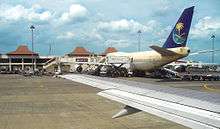
Tanjung Perak International Port is Indonesia's main hub port in Northern Surabaya.[47] Other international ports in East Java include Gresik Port and Java Integrated Industrial and Port Estate in Gresik Regency, Tanjung Tembaga Probolinggo Port and Banyuwangi Port.[48] National ports are Bawean Port in Gresik Regency, Pasuruan Port in Pasuruan City, Sapudi Port in Sumenep Regency, Kalbut Port and Anchor Port in Situbondo Regency, Sapeken Port in Sumenep Regency, Kangean Port in Sumenep Regency, and Muncar Port in Banyuwangi Regency. East Java has a number of ferry ports, including Ujung Port (Surabaya), Kamal (Bangkalan, Madura) Port, Ketapang Port (Banyuwangi), Kalianget Port (Sumenep), and Jangkar Port (Situbondo). Ujung-Kamal route connects Java island (Surabaya) with Madura island, Ketapang Ferry Port connects Java Island with Bali, Jangkar-Kalianget Route connects Java (Situbondo) with Madura Island, and Kalianget also connects Madura Island with small islands in the Java Sea (Kangean and Masalembu).[48]
Airports
Juanda International Airport in Sidoarjo Regency, located in the suburb of Surabaya and connects the city with major cities in Indonesia and most major cities outside Indonesia. Other international airport is Banyuwangi International Airport, which connects the city with Kuala Lumpur, Malaysia. In Malang, there is a regional airport that connects the city with Jakarta and Bali, namely Abdul Rachman Saleh Airport. In addition, there are other public airports in the province such as Notohadinegoro Airport in Jember Regency, Iswahyudi Air Force Base in Madiun Regency, and Trunojoyo Airport in Sumenep Regency.[49]
Art and culture
Art
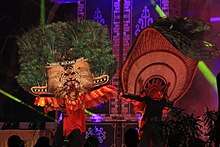
East Java has a number of distinctive art. Ludruk is one of the East Javanese art is quite well known, namely the art of the stage that generally all the players are male. Unlike the Ketoprak which tells the life of the palace, ludruk tells the daily life of ordinary people, often spiced with humor and social criticism, and generally opened with Dance Remo, and parikan. Currently traditional ludruk groups can be found in the area of Surabaya, Mojokerto and Jombang; although its presence increasingly defeated by modernization.
Reog from Ponorogo is a typical art that has been patented since 2001, and has now also become the icon of East Javanese art. Staging reog accompanied by horse braid (kuda lumping) are accompanied by elements of the occult.[50] Famous arts of East Java include puppet purwa East Javanese style, mask mastermind in Madura, and made. In the area Mataraman Middle Javanese arts such as Ketoprak, and shadow puppets are quite popular. Famous legend of East Java, among others Damarwulan, Angling Darma, and Sarip Tambak-Oso.

Traditional dance in East Java can be generally grouped into Middle Javanese style, East Javanese style, Osing style and Madurese styles. Classical dances include gandrung, gambyong dance, dance srimpi, dance bondan, and wanderer. There is also a sort of lion dance culture in East Java. Art exists in two districts namely, Bondowoso, and Jember. Singo Wulung is a distinctive culture Bondowoso. While Jember have the tiger kadhuk. Both are art that is rarely encountered.
Culture
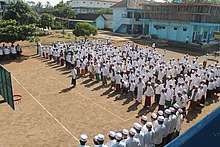
Culture and customs of Javanese in the western part of East Java received a lot of influence from the Middle Javanese, so this area is known as Mataraman, indicating that the area was once the territory of the Sultanate of Mataram. The area includes the former residency of Madiun (Madiun, Ngawi, Magetan, Ponorogo, Pacitan), ex-residency Kediri (Kediri, Tulungagung, Blitar, Trenggalek, Nganjuk), and part of Bojonegoro. As is the case in Central Java, wayang kulit, and Ketoprak quite popular in this region.
East Java's west coast region is heavily influenced by the Islamic culture. This area covers an area of Tuban, Lamongan and Gresik. In the past the north coast of East Java is the entry area, and the center of the development of Islam. Five of the nine members of the walisongo are buried in this area.
In the area of ex-residency of Surabaya (including Sidoarjo, Mojokerto and Jombang), and ex-residency Malang, had little cultural influence Mataraman, considering this region is an area arek (the term for offspring Kenarok), especially in the area of Malang that make this area difficult to be affected by Mataraman culture.
Customs in horse hooves region heavily influenced by the culture of Madura, given the magnitude of Madura tribe population in the region. Osing social mores of the culture is a blend of Java, Madura and Bali. While the Tenggerese tribe is heavily influenced by Hindu culture.[51]
Villagers in East Java, as well as in Central Java, has ties based on friendship, and territorial. Various ceremonies were held, among others: tingkepan (ceremony gestational age of seven months for the first child), babaran (ceremony before the birth of the baby), sepasaran (ceremony after the baby was five days), Pitonan (ceremony after the baby was seven months old), circumcision, fiancé.
East Java's population generally embraced monogamy. Prior to application, the men doing the show nako'ake (ask if the girl already had a husband), once that is done peningsetan (application). The wedding ceremony was preceded by a gathering or kepanggih. Communities on the west coast: Tuban, Lamongan, Gresik, even Bojonegoro has a habit of women's families applying common man (Ganjuran), different from the usual habits of other regions in Indonesia, where the men apply for women. And generally men will then be entered into the family of the woman.
To pray for the deceased person, usually a family party did send donga on day 1, 3rd, 7th, 40th, 100th, 1 year and 3 years after death.
Education
East Java is the province with the highest number of public universities in Indonesia.[52] Three major cities for universities are Surabaya, Malang, and Jember; there is also a university at Bangkalan on Madura island. Among them, University of Airlangga, Universitas Brawijaya, and Institut Teknologi Sepuluh Nopember are the most famous of the universities.
Another important form of education that is available in most cities in East Java is the pesantren. This is a kind of socio-education organized by Islamic clerics, and associated with local or national Muslim organizations. Jombang and Ponorogo is a famous region for its pesantren.[53]
Media
East Java supports several regional media outlets. Local newspapers with provincial news reach their readers earlier than their competitors from Jakarta. In the spirit of "providing more news from around readers", most newspapers even issue municipal sections which are different among their distribution areas. More startups media also develop for younger generation.
- Jawa Pos Group, one of the major newspaper groups in Indonesia, based in Surabaya
- Surya, newspaper based in Surabaya (owned by Kompas Group)
- Suara Surabaya (E100 FM), most famous local radio and internet news in Surabaya and East Java
- IDN Times, multiplatform media for millennials and generation z people
Tourism
Malang metropolitan region is a famous tourist destination in Indonesia with the City of Batu as its center.[54]
East Java has a number of interesting sights. One of the tourist icon is Mount Bromo in East Java, which is inhabited by the Tengger tribe, where the ceremony is held every year Kasada. In the mountainous region of Tengger also there is a waterfall that is Madakaripura which is the last hermitage Mahapatih Gajah Mada before serving in the kingdom of Majapahit. Madakaripura Waterfall has a height of about 200 meters, which makes it the highest waterfall on the island of Java and the second highest in Indonesia. East Java also has some other mountainous tourist area of which is Malang Raya mountainous area known as the natural mountain tourist area that includes Malang and Batu. Tretes and Trawas mountainous areas, are also known to have characteristics such as Puncak area in West Java province. Other natural attractions in East Java is the National Park (4 of 12 National Parks in Java) and Taman Safari Indonesia II in Prigen.
East Java is also contained relics of history in the classical era. Trowulan sites in Mojokerto, once the center of the Majapahit Kingdom, there are dozens of temples and tombs of the kings of Majapahit. Other temples spread throughout much of East Java, including Penataran temple in Blitar.[55] In Madura, Sumenep is the center of the kingdom of Madura, where there are Kraton Sumenep, museums, and the tombs of the kings of Madura (Asta Tinggi Sumenep).
East Java is known for its coastal scenery.[56] On the south coast there is the Prigi Beach, Pelang Beach and Pasir Putih Beach in Trenggalek, Popoh Beach in Tulungagung, Ngliyep Beach, and tourism areas such as the Jatim Park, Museum Angkut, Batu Secret Zoo, Batu Night Spectacular, Eco Green Park in Batu, and the Watu Ulo Beach in Jember. East Java also has a beach that the waves is one of the best in the world, namely the Plengkung Beach located in Banyuwangi. In addition there Kenjeran Beach in Surabaya, and the White Sand Beach in Situbondo. Lake in East Java, among others Sarangan in Magetan, Ir. Sutami Dam in Malang, and Selorejo Dam in Blitar.
In the coastal area of the north there are a number of tombs of the saints, which are places of pilgrimage for Muslims.[57] Five of the nine walisongo are buried in East Java: Sunan Ampel in Surabaya, Sunan Giri, and Malik Ibrahim in Gresik, Sunan Drajat in Paciran (Lamongan), and Sunan Bonang, Tuban. In the northern coastal region there are a number of caves, including Maharani Cave in Lamongan and Tuban Akbar Cave and Cave Gong located in Pacitan. Other pilgrimage sites include the tomb of Indonesia's first president Sukarno, in Blitar, as well as the tomb of the fourth Indonesian president Abdurrahman Wahid, known as Gus Dur, in Jombang.
Malang Metropolitan Region is a leading tourist destination in Indonesia with the City of Batu as its center. Malang has various tourist areas including volcanoes to beaches, as well as man-made tour of the history of travel to an international-class theme park with the support of inter-provincial transportation via trains, buses, and airplanes are available in Malang. Surabaya is the center of government, entertainment, financial, and business center of East Java, where there are Tugu Pahlawan, the Museum MPU Tantular, Surabaya Zoo, Submarine Monument, Ampel Region, and the Downtown Tunjungan area.
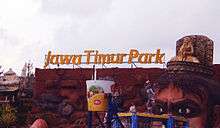 Jawa Timur Park in Batu
Jawa Timur Park in Batu Madakaripura waterfall in Probolinggo
Madakaripura waterfall in Probolinggo Ijen crater in Banyuwangi
Ijen crater in Banyuwangi Kedung Tumpang beach in Tulungagung
Kedung Tumpang beach in Tulungagung House of Sampoerna, Surabaya
House of Sampoerna, Surabaya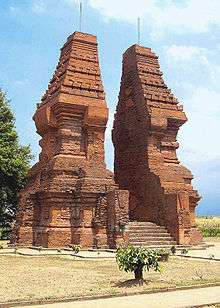
 Sempu Island, located in the south of Malang
Sempu Island, located in the south of Malang
National parks
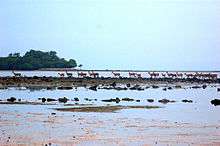
- Meru Betiri National Park - Between Jember and Banyuwangi districts, this park covers 580 km2 (224 sq mi). Hard to get to, it contains coastal rainforest and scenery and is home to abundant wildlife.
- Alas Purwo National Park - This 434 km2 (168 sq mi) park is formed by the Blambangan Peninsula (southeastern Java). Comprising mangrove, savanna, lowland monsoon forests and beaches, the park's name means First Forest in Javanese. Javanese legend says that the earth first emerged from the ocean here.
- Baluran National Park - This 250 km2 (97 sq mi) national park is located in northeastern Java, known as The Little Africa, formerly extensive savanna has been largely replaced by Acacia.
- Bromo Tengger Semeru National Park - Located in East Java at the region of Probolinggo and Pasuruan, 70 km (43 mi) from Surabaya the capital city of East Java province. Mount Bromo is one of the great hiking and trekking destinations for overseas tourists. The scenic view of Bromo also attracts hundreds of photo enthusiasts to see the views there.
Cuisine
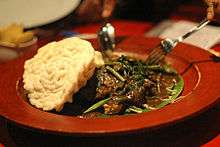
Some typical East Javanese dishes include Bakso Malang, Rawon, and Tahu Campur Lamongan.[58] Surabaya is famous for Rojak Cingur, Semanggi, Lontong Balap, clam satay, mussels, and rice cakes.[59] Malang is popular for a variety of processed fruits (especially apples), tempeh crisps, Bakpao telo, Bakso Malang, rawon, and Cwie noodles.[60] Kediri is famous for tahu takwa, tahu pong, tungku fried rice and getuk pisang.[61][62] Madiun is known for pecel madiun, and as a producer of Brem.[63] The subdistrict of Babat, Lamongan is famous as a producer of wingko.[64] Bondowoso is also well known as a producer of tape. Gresik famous is for nasi krawu, otak-otak bandeng, bonggolan. Sidoarjo is famous for shrimp crackers, shrimp paste, and petis. Ngawi is famous[65] for tempeh chips, tahu tepo, and nasi lethok. Blitar has the typical food that is pecel. Rambutan is also native to Blitar. Banyuwangi is famous[66] for sego tempong, salad soup, and pecel rawon. Jember have special food made of tape that is Suwar-suwir and tape proll that is very sweet. Corn is known as one of the staple food of the Madurese, while cassava is processed into gaplek, a staple food used to be a part of the population in Pacitan and Trenggalek. Tulungagung is famous for its lodho, goat satay and pati rice.[67]
Sports

East Java is the province with the highest number of professional football clubs in Indonesia and also province with clubs in top division league.[68] By 2019 season, Indonesian First League clubs from East Java are Persela, Madura United, Arema, and Persebaya. Arema and Persebaya are football clubs from East Java who have become top teams in Indonesia by repeatedly winning championships and national competitions and often as representatives of Indonesia in AFC Champions League and AFC Cup between clubs in Asia.
East Java once hosted the National Sports Week (PON), namely PON VII in 1969, and PON XV in 2000, and became the overall champion of PON in 2000, and 2008. Since 1996 the East Java Football Team always won medals gold was included in 2008, and was recorded as the fourth gold medal received consecutively.
East Java has several professional basketball clubs, mainly in Surabaya. The famous basketball clubs namely CLS Knights Indonesia and Pacific Cesar Surabaya. East Java is also the venue for several bicycle racing events namely Tour de East Java and Tour de Ijen.[69][70]
International relations
East Java is twinned with:
See also
- Districts of East Java
- State of East Java
- State of Madura
References
Citations
- "Statistik Indonesia 2018". Badan Pusat Statistik. Retrieved 24 July 2018.
- "Estimasi Penduduk Menurut Umur Tunggal Dan Jenis Kelamin 2014 Kementerian Kesehatan" (PDF). Archived from the original (PDF) on 8 February 2014. Retrieved 9 April 2014.
- Indonesia's Population: Ethnicity and Religion in a Changing Political Landscape. Institute of Southeast Asian Studies. 2003.
- "Keagamaan 2009". Archived from the original on 4 March 2016. Retrieved 13 August 2010.
- "Indonesia". Badan Pusat Statistik. Retrieved 20 May 2020.
- "BPS Provinsi Jawa Timur". jatim.bps.go.id. Retrieved 18 September 2018.
- Badan Pusat Statistik, Jakarta, 2019.
- Dennell, Robin (2009). The Palaeolithic Settlement of Asia. Cambridge: Cambridge University Press. p. 155. doi:10.1017/CBO9780511818882. ISBN 978-0-521-84866-4.
- Curtis, Garniss; Lewin, Roger (2000). Java Man: How Two Geologists Changed Our Understanding of Human Evolution. Chicago: University of Chicago Press. p. 70. ISBN 978-0-226-78734-3.
- Storm, Paul (1995). The evolutionary significance of the Wadjak skulls. Leiden: Nationaal Natuurhistorisch Museum.
- Weatherford, Jack (2004), Genghis khan and the making of the modern world, New York: Random House, p. 239, ISBN 0-609-80964-4
- "East Java | province, Indonesia". Encyclopedia Britannica. Retrieved 1 March 2019.
- Affan, Heyder (19 June 2017). "Arkeolog dan ahli naskah tanggapi klaim Majapahit sebagai kerajaan Islam". Retrieved 1 March 2019.
- Ying-Yai Sheng-Lan. Ma Huan, Translated from the Chinese text edited by Feng Ch’eng-Chün with introduction, notes and appendices by J. V. G. Mills. 1433. p. 138.
- Mashad, Dhurorudin (1 January 2014). Muslim Bali: Mencari Kembali Harmoni yang Hilang (in Indonesian). Pustaka Al Kautsar. ISBN 9789795926665.
- James Minahan (2012). Ethnic Groups of South Asia and the Pacific: An Encyclopedia. ABC-CLIO. ISBN 978-15-988-4660-7.
- Yingya Shenglan. Ma Huan, Translated from the Chinese text edited by Feng Ch’eng-Chün with introduction, notes and appendices by J. V. G. Mills. 1970. p. 89.
- Ames, Glenn J. (2008). The Globe Encompassed: The Age of European Discovery, 1500-1700. p. 99.
- Atkins, James (1889). The Coins And Tokens Of The Possessions And Colonies Of The British Empire. London: Quaritch, Bernard. p. 213.
- "Kota Malang Masih Hadapi Permukiman Kumuh". Republika Online (in Indonesian). 10 February 2017. Archived from the original on 16 March 2018. Retrieved 20 February 2019.
- "12 Fakta Ranupani, Desa di Kaki Semeru yang Suhu Udaranya Saat Ini Capai Minus 4 Derajat Celcius". www.msn.com (in Indonesian). Retrieved 26 September 2018.
- "World Weather Information Service – Surabaya". World Meteorological Organization. Retrieved 11 December 2017.
- "Surabaya climate: Average Temperature, weather by month, Surabaya weather averages - Climate-Data.org". en.climate-data.org. Retrieved 6 November 2018.
- "INDONESIA - SURABAJA". www.globalbioclimatics.org. Retrieved 14 December 2018.
- "INDONESIA - SURABAJA (google web cache)". webcache.googleusercontent.com. Retrieved 14 December 2018.
- "Surabaya, Indonesia - Monthly weather forecast and Climate data". Weather Atlas. Retrieved 24 January 2019.
- "Climate: Tulungrejo, Bumiaji, Batu City". Climate-Data.org. Retrieved 18 December 2018.
- "BATU, INDONESIA". Weatherbase. Retrieved 19 May 2016.
- "Climate: Cemoro Lawang". Climate-Data.org. Retrieved 18 December 2018.
- Biro Pusat Statistik, Jakarta, 2011.
- Badan Pusat Statistik, Jakarta, 2018.
- Indeks-Pembangunan-Manusia-2014
- "Statistik Indonesia 2018". Badan Pusat Statistik. Retrieved 24 July 2018.
- Karina, Ernia (17 September 2015). "Serba-Serbi Kehidupan yang Cuma Dialami Oleh Arek-Arek Jowo Timur". Hipwee (in Indonesian). Retrieved 26 September 2018.
- Project, UCLA Language Materials (31 December 1600). "Profile of". Archived from the original on 30 December 2010. Retrieved 26 September 2018.
- "Population by Region and Religion in Indonesia". BPS. 2010.
- "Madurese language". Encyclopedia Britannica. Retrieved 26 September 2018.
- antaranews.com. "Khofifah: Perekonomian Indonesia Timur bergantung Jawa Timur". Antara News (in Indonesian). Retrieved 2 February 2019.
- "PDRB Provinsi Jawa Timur Atas Dasar Harga Berlaku Menurut Lapangan Usaha (Sub Kategori) Tahun 2010-2016 (Milyar Rupiah)". jatim.bps.go.id (in Indonesian). Archived from the original on 1 January 2017. Retrieved 2 February 2019.
- News, Top; Terkini; Pariwisata, Budaya &; Ekonomi; Hukum; Olahraga; Haji, Info; Politik; Mlaku-mlaku. "Kontribusi Pertumbuhan Ekonomi Jatim Didominasi Industri Pengolahan - ANTARA News Jawa Timur". Antara News (in Indonesian). Retrieved 2 February 2019.
- Indonesia, Geothermal (20 February 2017). "Daftar Pembangkit Listrik di Indonesia". Geothermal Indonesia. Retrieved 2 February 2019.
- Peter Nas (2002). "Java and De Groote Postweg, La Grande Route, the Great Mail Road, Jalan Raya Pos" (PDF). In: Bijdragen tot de Taal-, Land- en Volkenkunde. 158. pp. 707–725. Retrieved 25 October 2007.
- "Jatim akan Bangun Dua Jalan Tol Baru". Republika Online (in Indonesian). 14 July 2011. Archived from the original on 15 March 2019. Retrieved 15 March 2019.
- amilliontravels (23 October 2018). "HOW TO TRAVEL ACROSS JAVA BY TRAIN, INDONESIA -". Retrieved 15 March 2019.
- "Indonesia Railway Network and Logistics | GBG". www.gbgindonesia.com. Retrieved 15 March 2019.
- "HISTORY OF PORT TANJUNG PERAK". www.eastjava.com. Retrieved 15 March 2019.
- News, Nusantara Maritime. "East Java Hunger to be a Maritime City | Nusantara Maritime News". Archived from the original on 1 June 2017. Retrieved 15 March 2019.
- JawaPos.com. "Jatim Provinsi dengan Bandara Terbanyak". www.jawapos.com (in Indonesian). Archived from the original on 15 March 2019. Retrieved 15 March 2019.
- "Reog Ponorogo Dance from Indonesia - History and Development - Facts of Indonesia". Facts of Indonesia. 10 April 2017. Retrieved 7 November 2018.
- Budi, Arifina. "Ini Keunikan yang Hanya Dimiliki Masyarakat Jawa Timur | Good News from Indonesia". Good News From Indonesia (in Indonesian). Retrieved 7 November 2018.
- Statistics Indonesia. "Jumlah Perguruan Tinggi, Mahasiswa, dan Tenaga Edukatif (Negeri dan Swasta) di Bawah Kementrian Pendidikan dan Kebudayaan Menurut Provinsi tahun ajaran 2013/2014-2014/2015". www.bps.go.id. Archived from the original on 17 March 2019. Retrieved 17 March 2019.
- Lukens-Bull, R. (12 May 2005). A Peaceful Jihad: Negotiating Identity and Modernity in Muslim Java. Springer. ISBN 9781403980298.
- MalangTIMES. "Kuliner: Malang Duduki Peringkat Pertama Wisatawan Tertinggi Dari Empat Kota Ini | Malang TIMES". Malang TIMES (in Indonesian). Retrieved 7 November 2018.
- Academy, Himalayan. "Hinduism Today Magazine". www.hinduismtoday.com. Retrieved 7 November 2018.
- Times, IDN. "25 Pantai Tercantik di Pulau Jawa yang Bikin Kamu Lupa Rumah!". IDN Times (in Indonesian). Retrieved 18 September 2018.
- Walisongo. "Walisongo Pilgrimage : The Java island's First Moslem Missionaries". www.eastjava.com. Retrieved 7 November 2018.
- "East Java Foods & Fruits | East Java, Indonesia. A Tropical Paradise in The World". eastjava.com. Retrieved 18 September 2018.
- "Surabaya's Best Dishes And Where To Try Them!". Trip101. Retrieved 7 November 2018.
- Group, DestinAsian Media. "Indonesia Travel: Mealtime in Malang". DestinAsian. Retrieved 7 November 2018.
- "Tungku Fried Rice, the Culinary Tour that Must be Tried when Visiting Kediri - LOTUS GARDEN HOTEL". LOTUS GARDEN HOTEL. 21 February 2018. Retrieved 7 November 2018.
- Times, IDN. "7 Kuliner Paling Lezat di Kediri, Gak Bakal Rugi Nyobain Ini!". IDN Times (in Indonesian). Retrieved 7 November 2018.
- Times, IDN. "Bisa Jadi Oleh-Oleh, 8 Jajanan Khas Madiun Ini Enaknya Pol!". IDN Times (in Indonesian). Retrieved 7 November 2018.
- "√ 8 Makanan Khas Lamongan Favorit Masyarakat | Wisata Negeri". Wisata Negeri. 12 May 2018. Retrieved 7 November 2018.
- nusantara, ok. "5 Makanan Khas Ngawi Yang Terkenal". oknusantara.com. Retrieved 18 September 2018.
- Media, Kompas Cyber (25 December 2017). "7 Makanan Khas Banyuwangi, Siapkan Perut Anda! - Kompas.com". KOMPAS.com. Retrieved 18 September 2018.
- "7+ Makanan Khas Tulungagung yang Buat Kamu Ketagihan Makan Lagi!". Hamparan. 7 October 2017. Retrieved 18 September 2018.
- redaksi (12 October 2018). "Jawa Timur: Provinsi dengan Klub Profesional Terbanyak di Indonesia". Pandit Football Indonesia (in Indonesian). Retrieved 17 March 2019.
- "About Tour de East Java". Tour de East Java. Archived from the original on 16 May 2018. Retrieved 17 March 2019.
- "International Tour de Banyuwangi Ijen 2019 | Overview". www.procyclingstats.com. Retrieved 17 March 2019.
- Arts, Department of Culture and. "Sister State Relationships ~ DCA". Dca.wa.gov.au. Retrieved 17 February 2019.
- 市级友好城市 (in Chinese). wsb.sh.gov.cn. Retrieved 8 March 2020.
Bibliography
- Curtis, Garniss H.; Lewin, Roger; Swisher III, Carl C. (2001). Java Man: How Two Geologists Changed Our Understanding of Human Evolution. Chicago: University of Chicago Press. p. 70. ISBN 978-0-226-78734-3.
- Dennell, Robin (2008). The Palaeolithic Settlement of Asia. Cambridge: Cambridge University Press. p. 155. doi:10.1017/CBO9780511818882. ISBN 978-1-316-58307-4.
- Lukens-Bull, Ronald (2005). A Peaceful Jihad: Negotiating Identity and Modernity in Muslim Java. London: Palgrave Macmillan. ISBN 978-1-403-96658-2.
- Pramono, S.B. (2013). Piwulang Basa Jawa Pepak (in Javanese). Yogyakarta: Grafindo Litera Media. p. 148. ISBN 978-979-3-896-380.
- Weatherford, Jack (2004). Genghis Khan and the Making of the Modern World. New York City: Crown and Three Rivers Press. p. 239. ISBN 0-609-80964-4.
External links

- (in Indonesian) Official website
